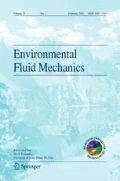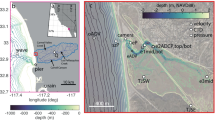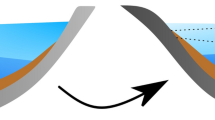Abstract
Lake water level fluctuations provide an important role in flushing shallow coastal embayments in the Great Lakes, especially if the embayment has a resonant response. Specifically, long-period waves (of periods 4–30 min) can excite resonance in coastal embayments, which greatly increases the flushing rates. We describe how resonance can explain the difference in responses of three shallow \(({\text{depth}} \,{\approx }2\, \hbox {m})\) coastal embayments of Lake Ontario and Lake Huron to similar long-period waves. Higher frequency water level fluctuations were analyzed to determine the most influential frequencies within the embayments. Observations in two adjacent embayments in Lake Huron show dramatic differences between their amplified responses to identical forcing, while in Frenchman’s Bay the oscillations are damped for the whole forcing spectrum. We model the water level response of the shallow coastal embayments to lake long-period wave forcing using a driven Helmholtz harmonic resonator. We compare and find favourable agreement \((R^{2}=78\,\%)\) between the amplification of water level fluctuations predicted by our model and field values for nearly enclosed embayments, where the Helmholtz mode dominates the energy of the oscillations. Additionally, strong peaks corresponding to the first three natural modes are observed in the water level oscillations of one of the Lake Huron embayments. This embayment has a wider entrance and its stronger amplified response can be explained using an analytical model based on an asymptotic theory of nonlinear resonance of free long-period oscillations induced by wind waves.















Similar content being viewed by others
References
Bedford KW (1992) The physical effects of the Great Lakes on tributaries and wetlands. J Great Lakes Res 18(4):571–589
Trebitz AS, Morrice JA, Cotter AM (2002) Relative role of lake and tributary in hydrology of Lake Superior coastal wetlands. J Great Lakes Res 28(2):212–227
Rueda FJ, Cowen EA (2005) The residence time of a freshwater embayment connected to a large lake. Limnol Oceanogr 50(5):1638–1653
Hamblin P, He C (2003) Numerical models of the exchange flows between Hamilton Harbour and Lake Ontario. Can J Civ Eng 30:168–180
Trebitz A (2006) Characterizing seiche and tide-driven daily water level fluctuations affecting coastal ecosystems of the Great Lakes. J Great Lakes Res 32:102–116
Seelig WN, Sorensen RM (1977) Hydraulics of Great Lakes inlets. Technical Paper 77–8, U.S Army, Corps of Engineers, Coastal Engineering Research Center
Herdendorf CE (1990) Great lakes estuaries. Estuaries 13(4):493–503
Keough JR, Thompson TA, Guntenspergen GR, Wilcox DA (1999) Hydrogeomorphic factors and ecosystem responses in coastal wetlands of the Great Lakes. Wetlands 19:821–834
Mortimer CH (1987) Fifty years of physical investigations and related limnological studies on Lake Erie, 1928–1977. J Great Lakes Res 13(4):407–435
Chen MY, Mei CC, Chang CK (2006) Low-frequency spectra in a harbour excited by short and random incident waves. J Fluid Mech 563:261–281
Girolamo PD (1996) An experiment on harbour resonance induced by incident regular waves and irregular short waves. Coast Eng 27:47–66
Jordan TF, Stortz KR, Sydor M (1981) Resonant oscillation in Duluth-Superior Harbor. Limnol Oceanogr 26:186–190
Kofoed-Hansen H, Sloth P, Serensen OR, Fuchs J (2000) Combined numerical and physical modelling of seiching in an exposed new marina. Coast Eng 2000:3600–3614. doi:10.1061/40549(276)281
Miles J (1974) Harbor seiching. Annu Rev Fluid Mech 6(1):17–35
Mullarney CJ, Hay EA, Bowen JA (2008) Resonant modulation of the flow in a tidal channel. J Geophys Res 113:1–20
Rabinovich AB (2008) Seiches and harbour oscillations. Tech. rep, Handbook of Coastal and Ocean Engineering World Scientific
Rueda FJ, Cowen EA (2005) Exchange between a freshwater embayment and a large lake through a long, shallow channel. Limnol Oceanogr 50(1):169–183
Skafel MG (2000) Exchange flow between Hamilton Harbour and Cootes Paradise. J Great Lakes Res 26(1):120–125
Wu J, Tsanis I, Chiocchio F (1996) Observed currents and water levels in Hamilton Harbour. J Great Lakes Res 22:224–240
Bortoluzzi T (2013) Spatial and temporal patterns in the hydrology, water chemistry and algal nutrient status of Delta Marsh, as influenced by the hydrology of adjoining Lake Manitoba. Ph.D. thesis, University of Manitoba
Bouchard V (2007) Export of organic matter from a coastal freshwater wetland to Lake Erie: an extension of the outwelling hypothesis. Aquat Ecol 41:1–7
Wells MG, Sealock L (2009) Summer water circulation in Frenchman’s Bay, a shallow coastal embayment connected to Lake Ontario. J Great Lakes Res 35:548–559
Munk W (1951) Origin and generation of waves. In: Proceedings of the first coastal engineering conference, Long Beach, 1–4
Imberger J, Hamblin P (1982) Dynamics of lakes, reservoirs, and cooling ponds. Annu Rev Fluid Mech 14:153–187
As-Salek JA, Schwab DJ (2004) High-frequency water level fluctuations in Lake Michigan. J Waterw Port Coast Ocean Eng 130:45–53
Huntley DA (1976) Long-period waves on a natural beach. J Geophys Res 81(36):6441–6449
Guza RT, Bowen AJ (1975) The resonant instabilities of long waves obliquely incident on a beach. J Geophys Res 90:4529–4534
Mei CC, Agonz Y (1989) Long-period oscillations in a harbour induced by incident short waves. J Fluid Mech 208:595–608
Longuet-Higgins MS, Stewart RW (1962) Radiation stress and mass transport in gravity waves, with application to surf beats. J Fluid Mech 13(4):481–504
Maas LRM (1997) On the nonlinear Helmholtz response of almost-enclosed tidal basins with sloping bottoms. J Fluid Mech 349:361–380
Rueda F, Schladow S (2002) Quantitative comparison of models for barotropic response of homogeneous basins. J Hydraul Eng 128:201–213
Miles JW, Munk WH (1961) Harbor paradox. J Waterw Harb Div 87:111–130
Miles JW, Lee YK (1975) Helmholtz resonance of harbours. J Fluid Mech 67(3):445–465
Bowers EC (1977) Harbour resonance due to set-down beneath wave groups. J Fluid Mech 79:71–92
Wu JK, Liu PLF (1990) Harbour excitations by incident wave groups. J Fluid Mech 217:595–613
Madsen PA, Fuhrman DR, Wang B (2006) A Boussinesq-type method for fully nonlinear waves interacting with a rapidly varying bathymetry. Coast Eng 53:487–504
Bellotti G (2007) Transient response of harbours to long waves under resonance conditions. Coast Eng 54(9):680–693. doi:10.1016/j.coastaleng.2007.02.002
Losada IJ, Gonzalez-Ondina JM, Diaz-Hernandez G, Gonzalez EM (2008) Numerical modeling of nonlinear resonance of semi-enclosed water bodies: description and experimental validation. Coast Eng 55(1):21–34. doi:10.1016/j.coastaleng.2007.06.002
Sorensen J, Sydor H, Costello M (2004) Analysis of Lake Superior seiche activity for estimating effects on pollution transport in the St. Louis River estuary under extreme conditions. J Great Lakes Res 30:293–300
Terra GM, van de Berg WJ, Maas LRM (2005) Experimental verification of Lorentz’ linearization procedure for quadratic friction. Fluid Dyn Res 36:175–188
Hamblin P (1982) On the free surface oscillations of Lake Ontario. Limnol Oceanogr 27(6):1029–1049
Schwab DJ, Rao DB (1977) Gravitational oscillations of Lake Huron, Saginaw Bay, Georgian Bay, and the North Channel. J Geogr Res 82(15):2105–2116
Torrence C, Compo GPA (1998) Practical guide to wavelet analysis. Bull Am Meteorol Soc 79(1):61–78
Welch PD (1967) The use of fast Fourier transform for the estimation of power spectra: a method based on time averaging over short, modified periodograms. IEEE Trans Audio Electroacoust 15(2):70–73
Smith SW (1999) The scientist and engineer’s guide to digital signal processing. California Technical Publishing, San Diego
Priestley MB (1981) Spectral analysis and time series, vol 1–2. Elsevier, Amsterdam
Percival DB, Walden AT (1993) Spectral analysis for physical applications. Cambridge University Press, Cambridge
Okihiro M, Guza RT, Seymour RJ (1993) Excitation of seiche observed in a small harbor. J Geogr Res 98:18,201–18,211
Lee JK, Roig LC, Jenter HL, Visser HM (2004) Drag coefficients for modeling flow through emergent vegetation in the Florida Everglades. Ecol Eng 22:237–248
Li C, Valle-Levinson A, Atkinson LP, Wong KC, Lwiza KMM (2004) Estimation of drag coefficient in James River Estuary using tidal velocity data from a vessel-towed ADCP. J Geophys Res 109:1–11
Mei CC, Stiassnie M, Yue DKP (2005) Theory and applications of ocean surface waves. World Scientific Publishing Company, Singapore
Yurick D (2010) National Marine Conservation Areas—extending Parks Canada’s Reach into Canada’s Oceans and Great Lakes. Georg Wright Forum 27(2):170–179
Canada Gazette (2002) Canada National Marine Conservation Areas Act, c. 18. Tech. rep., Canada
Canada Parks (2011) Fathom Five National Marine Park of Canada: State of the park report 2010. Tech. rep, Parks Canada, Gatineau, Quebec
Schaffer HA (1993) Infragravity waves induced by short-wave groups. J Fluid Mech 247:551–588
Grinsted A, Moore JC, Jevrejeva S (2004) Application of the cross wavelet transform and wavelet coherence to geophysical time series. Nonlinear Process Geophys 11:561–566
Thotagamuwage DT, Pattiaratchi CB (2014) Influence of offshore topography on infragravity period oscillations in Two Rocks Marina, Western Australia. Coast Eng 91:220–230. doi:10.1016/j.coastaleng.2014.05.011
Thotagamuwage DT, Pattiaratchi CB (2014) Observations of infragravity period oscillations in a small marina. Ocean Eng 88:435–445. doi:10.1016/j.oceaneng.2014.07.003
Mortimer CH, Fee EJ (1976) Free surface oscillations and tides of Lakes Michigan and Superior. Philos Trans R Soc Lond 281(1299):1–61
Acknowledgments
MGW acknowledges funding support from Natural Sciences and Engineering Research Council of Canada and the Ontario Ministry Research and Innovation Early Research Awards program. BH acknowledges support form Centre for Global Change Science at the University of Toronto and Natural Sciences and Engineering Research Council of Canada CGS fellowship.
Author information
Authors and Affiliations
Corresponding author
Rights and permissions
About this article
Cite this article
Hlevca, B., Wells, M.G. & Parker, S. Amplification of long-period waves in shallow coastal embayments of the Great Lakes . Environ Fluid Mech 15, 1181–1213 (2015). https://doi.org/10.1007/s10652-015-9406-3
Received:
Accepted:
Published:
Issue Date:
DOI: https://doi.org/10.1007/s10652-015-9406-3




